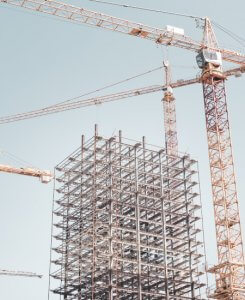- Construction

Longer Reads
Contractor held liable for cladding defects in the first fire safety claim concerning external wall insulation since the Grenfell tragedy
Martlet Homes Ltd v Mulalley & Co Ltd [2022] EWHC 1813 (TCC) (14 July 2022) (HHJ Stephen Davies)
This is the first substantive decision on a cladding safety dispute that has reached trial in the TCC since Grenfell Tower fire. Although the decision is the subject of appeal, with the introduction of the Building Safety Act 2022 introducing new causes of action and extending limitation periods, we will undoubtedly see similarly themed issues litigated in the coming years.
3 minute read
Published 1 November 2022
Key information
- Specialisms
- Real Estate
- Services
- Construction
In this case, the claimant housing association (Martlet) and owner of five 1960s residential tower blocks in Gosport, had in 2005, engaged the defendant contractor (Mulalley) to install external wall insulation (EWI) in the form of rendered cladding on the towers. Following Grenfell, Martlet discovered that the insulation used, consisted of the highly combustible expanded polystyrene (EPS). It also found that the mineral wool fire barriers required at each level to mitigate the risk of fire spread were defectively installed.
Martlet decided to completely remove the cladding and replace it with non-combustible stone wool insulation. It installed a “waking watch” fire patrol system in the meantime. It claimed £8 million from Mulalley for the costs of investigating, removing and replacing the cladding system, and the waking watch. It claimed Mulalley had committed installation breaches for the cladding and fire barriers, and in the alternative, specification breaches (specifically that the use of the EPS insulation itself breached the contract by way of not complying with Building Regulations, and thus the applicable fire safety standards at the time).
Mulalley admitted most of the installation breaches (workmanship failings in installing the cladding panels and the fire barriers). It denied, however, that those breaches of contract justified replacing the cladding instead of just repairing it, or the precaution of the waking watch patrol (which it argued was too remote to be recoverable in damages). It argued that the cladding system installed complied with applicable standards at the time, relying on certificates issued by the British Board of Agrément (BBA) as evidence of compliance with Building Regulations.
HHJ Davies found in Martlet’s favour, awarding approximately £8 million in damages for the costs of replacing the cladding and the waking watch patrol, with only modest reductions to the quantum of the damages claim. The TCC found Mullaley liable for both the installation and specification breaches.
Mulalley tried to argue causation; that as Martlet would have replaced the cladding after Grenfell, even ‘but for’ its defective installation, the installation breach had not caused any loss. HHJ Davies rejected this argument; Martlet’s loss was the diminution in value of the towers, although the cost of cure was usually the proper measure of loss in construction cases. The installation breach was an effective cause of Martlett’s loss. Yet it was the finding of the specification breach which justified replacing the cladding. Had the breach only related to installation, damages would have been limited to the cost of repairing the cladding.
HHJ Davies found that the EWI did not meet the performance or fire safety standards in the Building Regulations which applied at the time of the refurbishment, and should therefore not have been specified under the design and build contract. The cladding system’s design did not meet functional requirement B4(1) of the Building Regulations, meaning the external walls could not adequately resist the spread of fire for the height of the building.
The TCC found that Approved Document B, Fire Safety, 2000 edition, 2002 revision (ADB 2002), should not be construed as meaning that whatever was not expressly prohibited was permitted and acceptable. Approved Document B, 2006 (ADB 2006), which came into effect in April 2007, constituted a significant change from the regime in ADB 2002, introducing clear guidance that in buildings of over 18 metres, EWI should only be made from materials of limited combustibility.
HHJ Davies said the BBA certificate “cannot be said to amount to a form of ‘guarantee’ or ‘passport’ to compliance with the Building Regulations”. The Court rejected common defences including that Mulalley was entitled to blindly rely on the BBA certificate that the EWI system was appropriate, and that it could not be negligent if everyone else was doing the same.
The TCC made findings as to what was expected of Mulalley as contractor. The amended form JCT design and build contract included an unqualified design and specification duty which had been breached. This was an important point, as, in selecting and using combustible cladding, Mulalley was also in breach of its duty of reasonable care and skill in its design of the system, a duty that applied to the defendant as it would to an architect or other professional designer.
Further, the waking watch costs were considered to be a reasonable precautionary measure and thus not too remote to be recoverable. The need for temporary safety measures resulting from fire safety defects was foreseeable. Alternatively, the cost ought to be recoverable as mitigation compared with the greater costs of evacuation and providing alternative accommodation for residents.
Mulalley tried to argue that Martlet was only removing the cladding because of fire safety standards imposed post-Grenfell. However, it was found that the cladding did not comply with contemporaneous standards either, a decision that might be worrying for other contractors in its retrospectivity. The judge himself said that his decision will be “of particular interest, since it raises for determination the question whether or not the specification of combustible EWI rendered cladding breached fire safety standards as they existed in the early to mid 2000’s, well before the Grenfell Tower fire”.
Practitioners and those in the construction industry will appreciate the significance of this insight into the court’s likely approach in future cases. The decision may well set a precedent in future combustible cladding claims, although the decision is currently under appeal.
The TCC has shown that it will take a strict view on the compliance of an external wall system with the Building Regulations in force at the time of construction. Additionally, the recoverability of costs for the waking watch patrol will now be open to prospective claimants.
The judge emphasised that the case turned on the facts of this individual case, with its individual external wall system, the contract in place between the parties, the contemporaneous Building Regulations and Martlet’s proposed remedial scheme.
However, the decision also highlights the importance of a contractor meeting testing requirements at the time the works were completed, as without this, a project is unlikely to be judged compliant with Building Regulations. Defendant contractors should note that if proper testing can be evidenced, this may be a route to proving compliance with Building Regulations.
Find out more information on real estate disputes & meet our construction lawyers.
Related content
Longer Reads
Contractor held liable for cladding defects in the first fire safety claim concerning external wall insulation since the Grenfell tragedy
Martlet Homes Ltd v Mulalley & Co Ltd [2022] EWHC 1813 (TCC) (14 July 2022) (HHJ Stephen Davies)
This is the first substantive decision on a cladding safety dispute that has reached trial in the TCC since Grenfell Tower fire. Although the decision is the subject of appeal, with the introduction of the Building Safety Act 2022 introducing new causes of action and extending limitation periods, we will undoubtedly see similarly themed issues litigated in the coming years.
Published 1 November 2022
Associated sectors / services
Authors
In this case, the claimant housing association (Martlet) and owner of five 1960s residential tower blocks in Gosport, had in 2005, engaged the defendant contractor (Mulalley) to install external wall insulation (EWI) in the form of rendered cladding on the towers. Following Grenfell, Martlet discovered that the insulation used, consisted of the highly combustible expanded polystyrene (EPS). It also found that the mineral wool fire barriers required at each level to mitigate the risk of fire spread were defectively installed.
Martlet decided to completely remove the cladding and replace it with non-combustible stone wool insulation. It installed a “waking watch” fire patrol system in the meantime. It claimed £8 million from Mulalley for the costs of investigating, removing and replacing the cladding system, and the waking watch. It claimed Mulalley had committed installation breaches for the cladding and fire barriers, and in the alternative, specification breaches (specifically that the use of the EPS insulation itself breached the contract by way of not complying with Building Regulations, and thus the applicable fire safety standards at the time).
Mulalley admitted most of the installation breaches (workmanship failings in installing the cladding panels and the fire barriers). It denied, however, that those breaches of contract justified replacing the cladding instead of just repairing it, or the precaution of the waking watch patrol (which it argued was too remote to be recoverable in damages). It argued that the cladding system installed complied with applicable standards at the time, relying on certificates issued by the British Board of Agrément (BBA) as evidence of compliance with Building Regulations.
HHJ Davies found in Martlet’s favour, awarding approximately £8 million in damages for the costs of replacing the cladding and the waking watch patrol, with only modest reductions to the quantum of the damages claim. The TCC found Mullaley liable for both the installation and specification breaches.
Mulalley tried to argue causation; that as Martlet would have replaced the cladding after Grenfell, even ‘but for’ its defective installation, the installation breach had not caused any loss. HHJ Davies rejected this argument; Martlet’s loss was the diminution in value of the towers, although the cost of cure was usually the proper measure of loss in construction cases. The installation breach was an effective cause of Martlett’s loss. Yet it was the finding of the specification breach which justified replacing the cladding. Had the breach only related to installation, damages would have been limited to the cost of repairing the cladding.
HHJ Davies found that the EWI did not meet the performance or fire safety standards in the Building Regulations which applied at the time of the refurbishment, and should therefore not have been specified under the design and build contract. The cladding system’s design did not meet functional requirement B4(1) of the Building Regulations, meaning the external walls could not adequately resist the spread of fire for the height of the building.
The TCC found that Approved Document B, Fire Safety, 2000 edition, 2002 revision (ADB 2002), should not be construed as meaning that whatever was not expressly prohibited was permitted and acceptable. Approved Document B, 2006 (ADB 2006), which came into effect in April 2007, constituted a significant change from the regime in ADB 2002, introducing clear guidance that in buildings of over 18 metres, EWI should only be made from materials of limited combustibility.
HHJ Davies said the BBA certificate “cannot be said to amount to a form of ‘guarantee’ or ‘passport’ to compliance with the Building Regulations”. The Court rejected common defences including that Mulalley was entitled to blindly rely on the BBA certificate that the EWI system was appropriate, and that it could not be negligent if everyone else was doing the same.
The TCC made findings as to what was expected of Mulalley as contractor. The amended form JCT design and build contract included an unqualified design and specification duty which had been breached. This was an important point, as, in selecting and using combustible cladding, Mulalley was also in breach of its duty of reasonable care and skill in its design of the system, a duty that applied to the defendant as it would to an architect or other professional designer.
Further, the waking watch costs were considered to be a reasonable precautionary measure and thus not too remote to be recoverable. The need for temporary safety measures resulting from fire safety defects was foreseeable. Alternatively, the cost ought to be recoverable as mitigation compared with the greater costs of evacuation and providing alternative accommodation for residents.
Mulalley tried to argue that Martlet was only removing the cladding because of fire safety standards imposed post-Grenfell. However, it was found that the cladding did not comply with contemporaneous standards either, a decision that might be worrying for other contractors in its retrospectivity. The judge himself said that his decision will be “of particular interest, since it raises for determination the question whether or not the specification of combustible EWI rendered cladding breached fire safety standards as they existed in the early to mid 2000’s, well before the Grenfell Tower fire”.
Practitioners and those in the construction industry will appreciate the significance of this insight into the court’s likely approach in future cases. The decision may well set a precedent in future combustible cladding claims, although the decision is currently under appeal.
The TCC has shown that it will take a strict view on the compliance of an external wall system with the Building Regulations in force at the time of construction. Additionally, the recoverability of costs for the waking watch patrol will now be open to prospective claimants.
The judge emphasised that the case turned on the facts of this individual case, with its individual external wall system, the contract in place between the parties, the contemporaneous Building Regulations and Martlet’s proposed remedial scheme.
However, the decision also highlights the importance of a contractor meeting testing requirements at the time the works were completed, as without this, a project is unlikely to be judged compliant with Building Regulations. Defendant contractors should note that if proper testing can be evidenced, this may be a route to proving compliance with Building Regulations.
Find out more information on real estate disputes & meet our construction lawyers.
Associated sectors / services
- Construction
Authors
Need some more information? Make an enquiry below.
Subscribe
Please add your details and your areas of interest below
Article contributors
Adrian
BinghamPartner
Specialising in Construction and Real estate disputesIan
ChappellPartner
Specialising in Construction, Manufacturing and Real estate disputes
Enjoy reading our articles? why not subscribe to notifications so you’ll never miss one?
Subscribe to our articlesMessage us on WhatsApp (calling not available)
Please note that Collyer Bristow provides this service during office hours for general information and enquiries only and that no legal or other professional advice will be provided over the WhatsApp platform. Please also note that if you choose to use this platform your personal data is likely to be processed outside the UK and EEA, including in the US. Appropriate legal or other professional opinion should be taken before taking or omitting to take any action in respect of any specific problem. Collyer Bristow LLP accepts no liability for any loss or damage which may arise from reliance on information provided. All information will be deleted immediately upon completion of a conversation.
Close


































